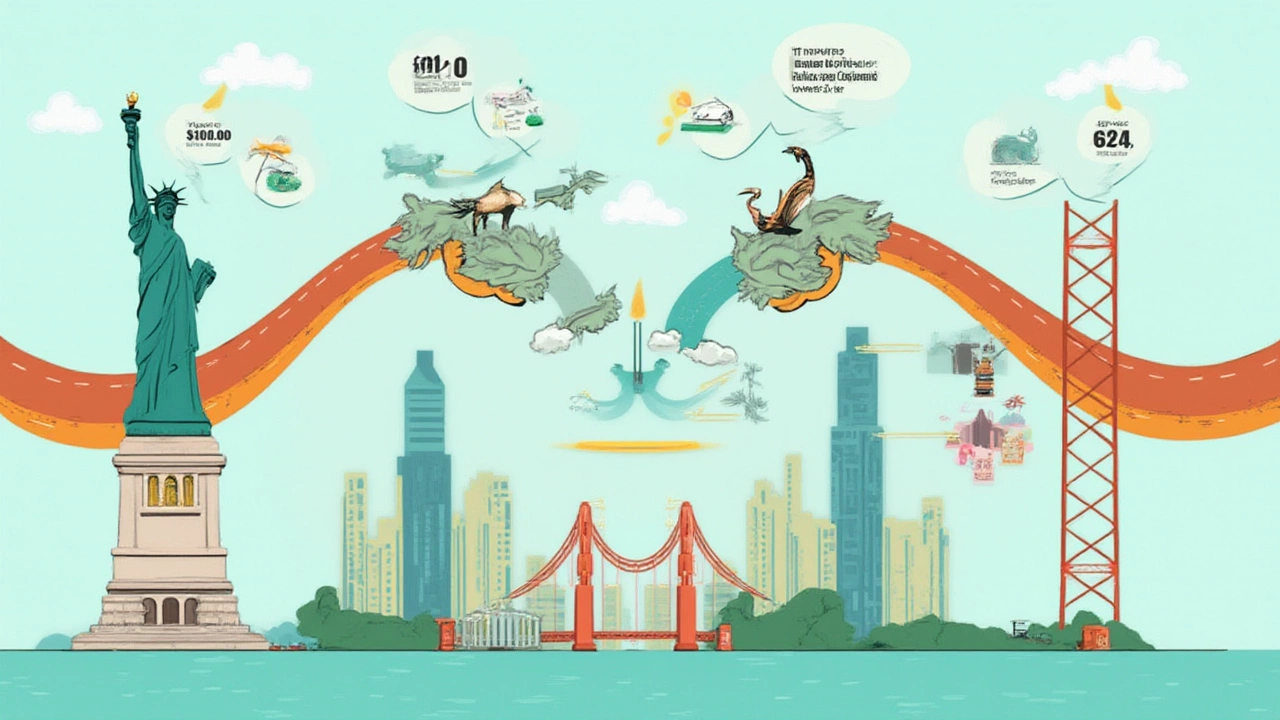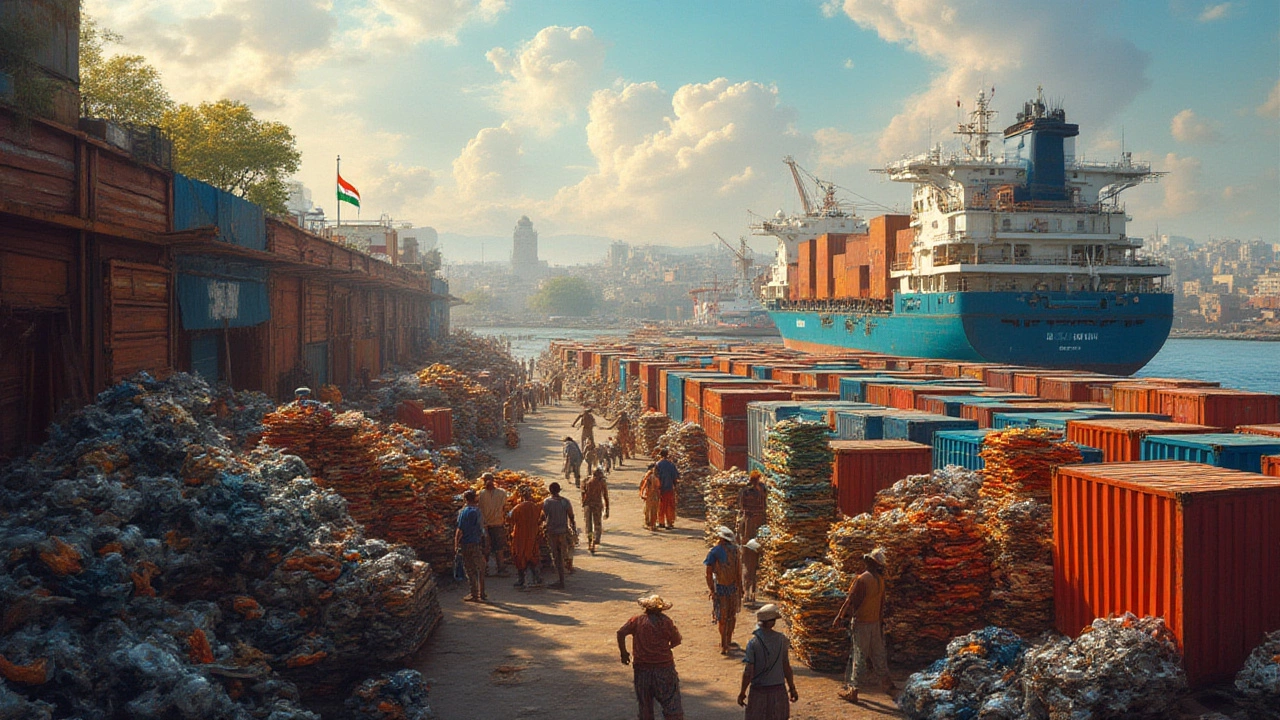What’s the first thing that pops to mind when you think of trade between India and the USA? You might picture software programmers making tech magic from Bengaluru, or spicy curries filling up takeout orders in Times Square. But the real trade story between these two giants is a lot more layered—and way bigger than most people guess. India exported a jaw-dropping $78.8 billion worth of goods to the US in 2023. That’s not pocket change. This partnership powers businesses on both sides, and the list of what’s shipped across the ocean would surprise even the savviest business kids.
What Products Does India Export Most to the USA?
If you line up all the goods that sail or fly between India and the USA, you get a wild cross-section of stuff. Some of it is your classic "Indian exports"—textiles, jewelry, and spices of course. Others are totally modern, like prescription drugs and IT services (which are counted separately from traditional goods, but we’ll stick to products for now). Here’s what’s actually heading to America.
The real rock stars of Indian exports to the US are:
- Pharmaceuticals and Medicines: India is called the world’s pharmacy for a reason. Nearly 40% of all generic drugs sold in the US come from India. Big brands like Sun Pharma and Dr. Reddy’s fill US pharmacies with everything from blood pressure pills to painkillers. In 2023, pharma products alone chipped in about $8 billion to the trade numbers.
- Precious Stones and Jewelry: Think sparkly diamonds and gold bling? India is a master at cutting, polishing, and setting stones. Surat is basically the Las Vegas of diamonds, with most stones in American wedding rings having passed through Indian hands first. Jewelry exports to the US clocked $16.6 billion last year, making them the biggest single category.
- Textiles and Apparel: Americans wear a lot of clothes made in India – from casual t-shirts and leggings to luxe scarves. The textile industry, especially cotton garments, shipped goods worth $8.4 billion to the US.
- Machinery and Electrical Equipment: Maybe not as flashy, but just as important, India now sends motors, auto parts, and even smart energy products like inverters. This segment is surging with innovation and fetches about $4 billion in revenue.
- Organic Chemicals: Used in everything from paints to plastics, these chemicals are a quiet backbone of India’s export machine and contribute around $2.3 billion.
- Spices, Tea, and Coffee: No Indian export roundup is complete without the sensory punch of its spices. From masalas to Assam tea, flavor rules. While not the top category, this sector still moves about $620 million a year just in spice exports.
- Leather Goods: Handbags, wallets, jackets, shoes – India’s leather exports to the US are stylish and hard-wearing, chipping in over $650 million annually.
India doesn’t just ship raw materials; it adds plenty of value along the way. For example, most US medical-grade cotton swabs and PPE kits during the pandemic hailed from factories near Mumbai and Chennai.
To get a sense of just how much the numbers have grown, here’s a simple table of India’s top five exported products to the US in the last full year, based on US Census Bureau and Indian Ministry of Commerce data:
| Product Category | Export Value (USD, 2023) |
|---|---|
| Precious Stones & Jewelry | $16.6 Billion |
| Pharmaceuticals | $8 Billion |
| Textiles & Apparel | $8.4 Billion |
| Machinery & Equipment | $4 Billion |
| Organic Chemicals | $2.3 Billion |
There’s also a steady stream of handicrafts, furniture, ceramics, and automotive parts. The magic is in this blend: old-world artistry meets high-tech ambition.
Quirky and Little-Known Export Stories
Everyone knows about software and spices, but some Indian exports are so surprising, they sound almost made up. Here are a few you likely never realized were part of the India-US connection:
- Eyebrow Thread: Beauty salons in the US use tons of thread made in India for brow-shaping. Andhra Pradesh supplies most of this cotton thread, which is wound, sterilized, and packed just for export.
- Frozen Shrimp: India is the top supplier of frozen shrimp to American supermarkets. In 2023, seafood exports to the US tallied $6.7 billion, mostly with shrimp that end up in California sushi rolls or Louisiana jambalayas.
- Incense Sticks: That cinnamon-y or sandalwood scent in yoga studios? Probably sourced from India—companies ship thousands of tons every year.
- Auto Components: It’s not just small bolts and screws. Major US brands like Ford fit Indian-made gearboxes and transmission parts in their models. A single plant in Pune produces millions of these units, shipped direct to Detroit.
- Yoga Mats: Big-box stores like Target stock mats that roll straight from Indian factories. Many are made from eco-friendly materials like jute and coconut fiber.
Even COVID-19 changed things—when US hospitals ran short of PPE, Indian companies stepped in to fill the gap, exporting everything from gloves to face shields to New York and Los Angeles. It shows that trade isn’t just numbers and contracts—it’s adaptability and meeting needs fast.

Behind the Scenes: How the Export Process Works
What does it take to get a product out of India and onto American store shelves? Exporting isn’t just about packing boxes. It’s a chain of choices, rules, and strategies. Here’s a real-world look at what exporters have to handle:
- Compliance and Documentation: Nothing moves without paperwork. Both Indian and US authorities have stacks of requirements. The most crucial are the Bill of Lading, Commercial Invoice, Certificate of Origin, and special regulatory documents for items like food or medicine (think FDA clearance).
- Quality Control: For food, pharma, textiles, and toys, the US has high safety and quality standards. Indian exporters send products through independent labs for rigorous tests.
- Finding Buyers: Some exporters show up at giant industry expos in Las Vegas or New York, while others hunt for retail buyers or wholesale distributors. Platforms like Alibaba, IndiaMART, and even LinkedIn are big hunting grounds.
- Packing and Shipping: Different products need different shipping modes—sea is cheap but slow, while air is fast for perishables like flowers or seafood. Mumbai and Chennai are the main sea ports for US-bound containers; Delhi and Hyderabad lead in air cargo.
- Payment and Banking: Most deals happen on a Letter of Credit or advance basis. International banking can be tricky, with ever-changing dollar-rupee rates.
If you’re aiming to start exporting, here are a few practical tips:
- Stay updated on US trade policy. America loves its tariffs and anti-dumping rules. Watch the news and follow official trade body reports—things change fast.
- Build an airtight digital presence. US importers start their search on Google and B2B platforms. Videos, clear catalogs, and easy contact info will set you apart.
- Partner with a logistics firm that knows the ropes. Indian ports are getting faster, but paperwork is still king, and a good freight forwarder will help.
- Don’t ignore packaging standards. The US expects clean, strong, eco-conscious designs. Compostable or recycled packaging is a bonus.
- Work with the Indian Export Promotion Councils. For almost any product you want to ship, there’s a council ready to help—from gems to garments.
Even big Indian brands started out catering to a single US retailer or restaurant group. Patience, research, and good networking make all the difference.
Why This Trade Relationship Matters (and How to Make It Work for You)
Here’s a wild stat: the US is India’s largest trading partner, and for the US, India is a top-ten supplier. This bond keeps growing. Every shirt, medicine bottle, or toy that makes it over feeds jobs in both economies. The ripple effect stretches beyond factories—think of the supply chains, the truckers, the IT pros monitoring shipments, even farmers harvesting cotton that ends up in LA boutiques.
Tariffs, regulatory spats, and global politics sometimes throw curveballs. Like when the US briefly hiked tariffs on Indian steel, or when India hiked duties on US almonds in return. Yet the numbers keep climbing, fueled by demand, Indian business creativity, and the diverse taste of American shoppers.
So, if you’re an exporter or a business dreamer, it’s worth knowing what works:
- Specialize where India already shines—pharma, textiles, gems, or processed foods.
- Double down on certifications like ISO and US FDA approvals. These open doors in American retail.
- Add a twist—eco-friendliness, handcrafted touches, or digital sales platforms—to catch buyers’ eyes.
- Make use of government schemes: The Indian government runs incentives like MEIS and RoDTEP to boost export earnings. These can shave costs or add rebates on your export bill.
- Get social—Instagram and Facebook aren’t just for direct sales. American shop owners love discovering new products there.
In the end, the US is a big, sometimes picky but always lucrative market. Indian exports aren’t just about what sells, but how quickly and creatively you can adapt. The next big thing Americans buy from India could be your idea—if you’re ready to put your product in a box, stamp it with ‘Made in India,’ and build your own piece of this massive $78+ billion story.

